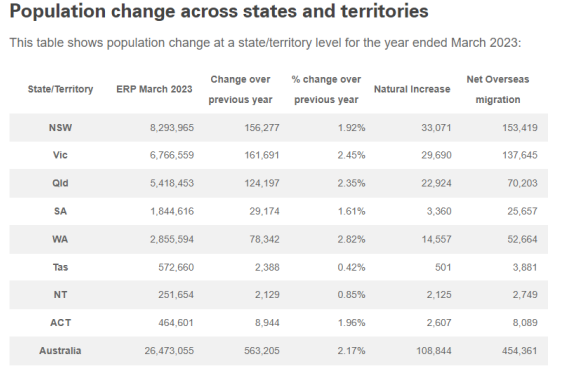Last week the Australian Bureau of Statistics released new population growth figures for Australia, States and Territories, as they do every quarter. These figures are up to the end of March 2023, and show that the nation has put the COVID slump well and truly behind it, and is now growing at a frenetic pace! Australia’s population at March 31, 2023, stood at 26,473,055 people, up by a whopping 563,205 people in one year, or 2.17% growth. If this is maintained for another quarter it will be the largest annual growth ever recorded Australia-wide. (Though, as a percentage the nation has grown faster off a smaller population base at other times.)
The main driver of this very high population growth remains overseas migration. During COVID, particularly the 2020–21 year, Net Overseas Migration (NOM) was negative, as our borders were closed and we had hotel quarantine for a small number of returning residents only. Fast forward two years and, with the borders open, there is a very high migration intake. Net Overseas Migration for the 12 months to March 2023 was +454,361. We normally record for years ended June, but if it’s the same by the next quarter, this would be more than 100,000 higher than the previous record set in 2009. For many years, NOM was around +150,000–200,000 p.a. Since 2006 it has been high, averaging between 200,000 and 250,000 p.a. So the current figure is close to double the average over the 10 years pre-COVID.
Some of this high Net Overseas Migration is due to the very high migration intake (ie. more people coming in). For the year ended March this was very high, at over 680,000 people entering the country to migrate permanently or long-term (>12 months). But it’s not all that much higher than the 620,000 recorded for the same period ended March 2020, just before COVID hit. The difference is that far fewer people are leaving the country (departures). For the year ended March 2023, there were only 226,000 departures, compared to 379,000 for the same period 3 years ago. Typically departures run between 250,000–300,000 p.a., though this does fluctuate a lot. This lower number of departures coupled with a high rate of arrivals brings us to a record NOM. It may be because many left during COVID – particularly students – when universities were closed, and we’re now playing catch-up.
This table shows population change at a state/territory level for the year ended March 2023:

Victoria
Incredibly, Victoria has returned to 2nd-highest population growth in the nation, with 2.45% for the year ended March. After recording negative growth just two years before it has bounced back with very high overseas migration.
New South Wales
New South Wales continues to lose the most people interstate, but it’s moderated compared to previous years, including Sydney’s lockdowns. It’s still running at over 30,000 p.a. though, mostly to Queensland. Because this loss pretty much offsets the natural increase (births minus deaths) in NSW, it means that the growth in our most populous state is almost 100% comprised of overseas migration.
Queensland
Queensland continues to grow strongly, but the very high growth of the previous year relative to other states was due to interstate migration, which has pulled back a bit. It is still by far the highest of any state/territory, though. Queensland gets a smaller share of overseas migration than the other eastern states, so overall growth for Queensland is not exceptionally high in the context of that state’s history (but it’s still growing strongly).
South Australia
South Australia has just retained a positive interstate migration in the post-COVID years, while most years before were strongly negative. High overseas migration here leads to a growth of over 29,000 all up for the Festival State, more than double the average growth of the past 20 years.
Western Australia
Western Australia has the highest growth rate of all, at 2.82% for the year ended March 2023. This was driven by all three components being strongly positive: WA is continuing to attract a lot of migrants from interstate in net terms, which has continued post-COVID, while the overseas migration of +52,664 for WA would be a record if maintained in the June quarter. WA’s fortunes only slightly follow national trends, and have a lot more to do with economic prosperity and mining boom and bust cycles.
Tasmania
Tasmania seems to have fallen back to a lower growth rate, primarily due to net interstate migration going negative again. There is still a high rate of overseas migration for Tasmania (<1% of the national total but a record for the state) but people leaving for other states is a drag on the population, and the older age profile means a low rate of natural increase due to fewer births and more deaths. Remember, though, these figures are all subject to review after the next Census (2026); after the previous (2021) Census, the ABS “found” 25,000 extra people unexpectedly in the Apple Isle…
The Territories
The two territories, NT and ACT both maintained positive growth but are both back to losing people to the states in next terms, so growth is not exceptional (but nowhere near negative, as we had seen a few years ago in the NT).
National, state and territory population is released every quarter by the ABS, usually about 6 months behind the reference period. The next update on the state and territory (and national) populations will be in December, when we’ll get the full year 2022–23 figures (year ended June). Then we’ll see definitively whether this is a record year.
Customer Service Manager:Michael Guo
Tel:0430680555
Email:office@ksiinvestments.com.au
Address:Suite 404, 53 Walker Street, North Sydney, NSW, 2060
General advice warning and Disclaimers
